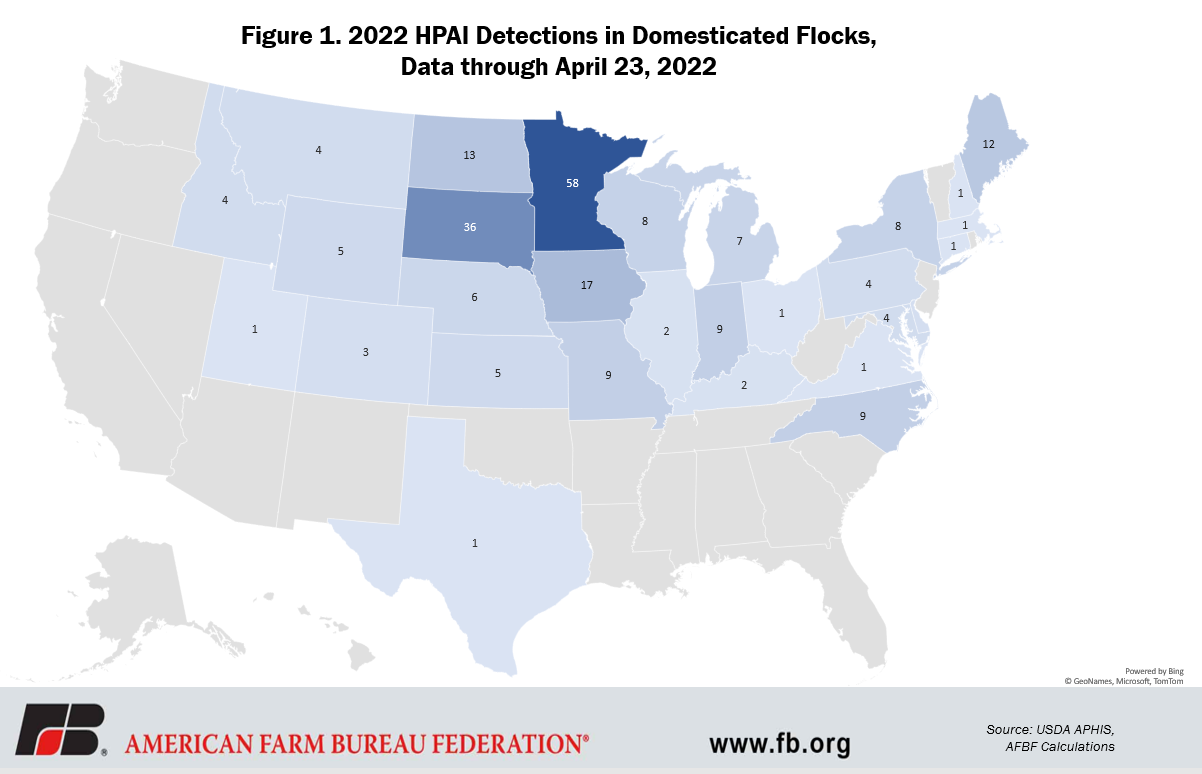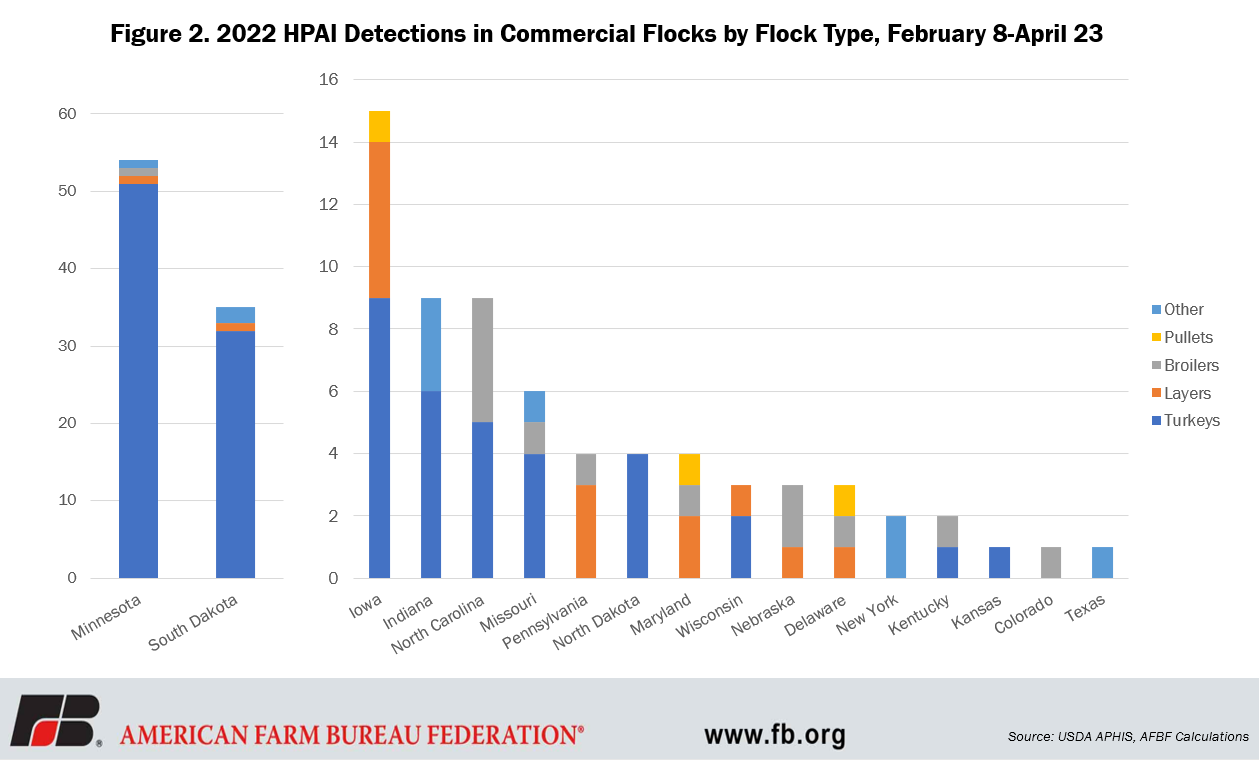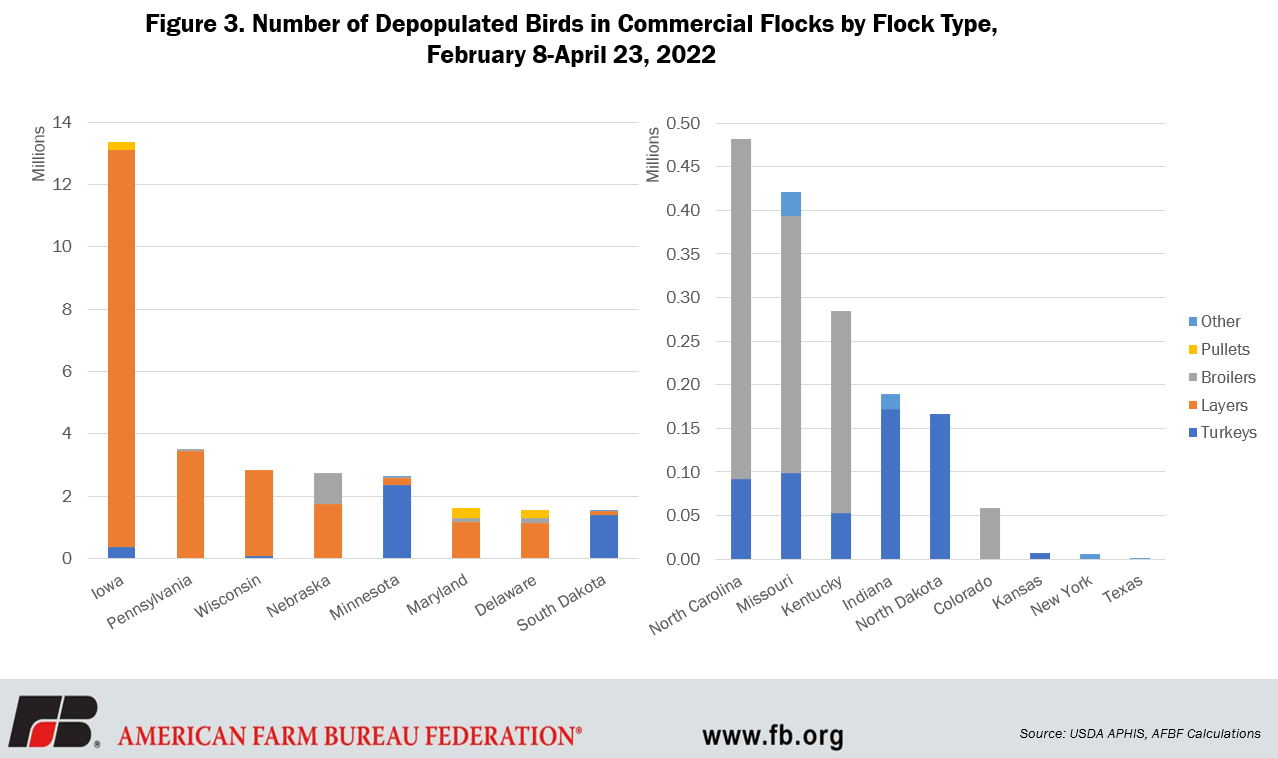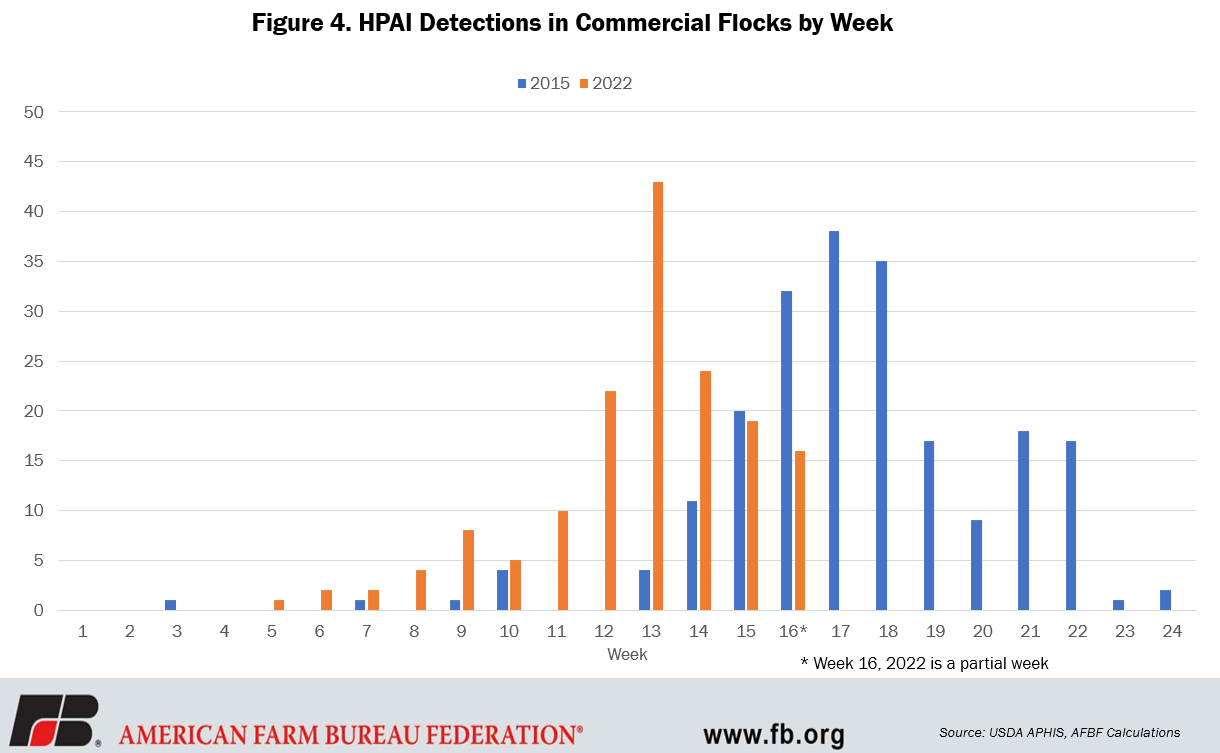High Path Avian Influenza Update: April 26
TOPICS
HPAI
photo credit: Getty
Veronica Nigh
Former AFBF Senior Economist
On April 12, we published an article describing the 2022 high path avian influenza outbreak and spread and compared it to the 2014-15 outbreak. At that time, there had been 158 cases of HPAI in domestic flocks, of which 104 were in commercial flocks. Because HPAI can spread so easily, in the two weeks since, there have been an additional 77 cases in domestic flocks, 52 of them in commercial flocks and three additional states – Pennsylvania, Idaho and Utah - have had an HPAI detection in a domesticated flock. Until the HPAI outbreak ends, we will be providing updated analysis on the current situation every two weeks. This is the first update.
Across Flock Type
Since the first detection in a domesticated flock on Feb. 8, through April 23, there have been 235 detections of HPAI in domesticated flocks across 29 states. This has led to the depopulation of nearly 31.5 million birds. One-third of all domestic flock detections have been among backyard flocks. Detections in 12 states – Michigan, Utah, Idaho, Montana, Wyoming, Maine, Illinois, Massachusetts, Ohio, New Hampshire, Connecticut and Virginia - have been exclusively in backyard, non-commercial flocks.

The 156 detections in commercial flocks have been in flocks of turkeys, layer hens, broilers, pullets and specialty commercial poultry. With respect to the number of detections, turkeys continue to be the hardest hit. Nearly half (49%) of all HPAI detections in domesticated flocks have been in turkeys. There have been 115 detections across 10 states – Wisconsin, Indiana, Minnesota, North Dakota, Kansas, South Dakota, North Carolina, Missouri, Iowa and Kentucky – in turkey flocks. These detections have led to the depopulation of nearly 4.8 million turkeys. Between April 8 and April 23 there were 39 additional detections in turkey flocks.
Since the beginning of the current outbreak there have been 15 detections in layer hen flocks across eight states - Wisconsin, Pennsylvania, Minnesota, South Dakota, Nebraska, Iowa, Maryland and Delaware. Five of the 15 detections occurred during the last two weeks (April 8 and April 23). Flocks of layer hens tend to be rather large, so despite the fact that only 6% of all domestic flock detections have been among layers, more than 23.3 million layer hens have been depopulated, which is nearly three-quarters (74%) of all depopulated domestic birds.
Nearly 2.3 million broiler birds have been depopulated in the current outbreak of HPAI. The 13 detections in broiler flocks represent 6% of total detections in domesticated flocks and have occurred across nine states – Pennsylvania, Minnesota, North Carolina, Nebraska, Colorado, Missouri, Maryland, Delaware and Kentucky. Four of the 13 detections occurred during the last two weeks (April 8 and April 23).
HPAI has been detected one time in each of three states – March 8 in Delaware, March 18 in Maryland and March 25 in Iowa. These three detections led to the depopulation of 830,269 pullets. There has not been a detection in a pullet flock in nearly a month.
There have been 10 detections of HPAI in “other” commercial flocks and facilities, of which four have occurred during the last two weeks (April 8 and April 23). “Other” commercial operations have included flocks of ducks, upland game, captive wild birds and poultry processors. Detections have occurred in six states – Indiana, Minnesota, South Dakota, Missouri, New York and Texas – and led to the depopulation of more than 125,000 birds.
Top States
While there have been detections of HPAI in commercial flocks in 17 states, some states have been hit harder than others. Based on detections in commercial flocks, 104 of the 156 total detections have occurred in three states. Minnesota and South Dakota lead the pack with 54 and 35 detections, respectively, primarily in turkey flocks. Iowa has had 15 detections, primarily in turkeys and laying hens.

Based on the number of depopulated birds, states that have detections in layer hen flocks have been the most impacted thus far. With nearly 13.4 million birds depopulated, Iowa has the unpleasant distinction of having lost the greatest number of birds thus far. Pennsylvania, which at the last writing had not yet had a detection, has had to depopulate 3.5 million birds between April 15 and April 22, nearly all of them layers. Wisconsin and Nebraska have both had to depopulate more than 2.5 million birds, primarily layers. Minnesota has had to depopulate more than 2.6 million birds, but nearly 90% of those birds have been turkeys, unlike the above states. Maryland and Delaware have both had to depopulate more than 1.5 million birds, primarily layers. The final state with more than a million birds depopulated is South Dakota, which has had to depopulate more than 1.5 million birds. Like Minnesota, more than 70% of the depopulated birds in Minnesota have been turkeys. The remaining nine states have each depopulated fewer than 0.5 million birds each.

Thankfully, It’s Not All Bad News!
While the outbreak is ongoing, the number of detections in commercial flocks has begun to fall week-over-week. From March 30-April 5 (week 13 in Figure 4) the number of detections in commercial flocks peaked at 43 but has fallen steadily each week since. In the last complete week of data - week 15, April 13-19 – there were 19 detections, fewer than half of the peak just two weeks earlier. As seen in Figure 4, a comparison of HPAI detections during the same week in 2015 and 2022 shows the 2022 outbreak began in commercial flocks earlier than it did in 2015. This resulted in the number of weekly detections in 2022 exceeding the number of weekly detections in 2015. However, with the number of detections falling significantly over the last two weeks, this trend finally ended in week 15, when the number of detections in 2015 was greater than the number of detections in 2022. One data point isn’t much to hang one’s hat upon, but since it is going in the right direction, we’ll take it.

APHIS Gets Additional Emergency Funding from CCC
In the event of an animal health emergency, USDA has the authority to request additional funds from the Commodity Credit Corporation (CCC) as necessary, and the Office of Management and Budget may make an apportionment to provide money to contain and eliminate an animal disease. On April 27, Agriculture Secretary Tom Vilsack acted on this authority, approving the transfer of nearly $263 million from the Commodity Credit Corporation to USDA’s Animal and Plant Health Inspection Service (APHIS) to directly support the HPAI response efforts. This funding follows $130 million in emergency funding from CCC in mid-March. Given the scope of the outbreak, APHIS quickly worked through the March emergency funds to address indemnity, diagnostics, field activities and other emergency response costs. “The funding allows APHIS to continue its critical work with state and local partners to quickly identify and address cases of HPAI in the United States.” USDA spent close to $900 million responding to the last outbreak, most of it on biosecurity, according to a Congressional Research Service report, but that also included $190 million in indemnity payments to producers.
Top Issues
VIEW ALL